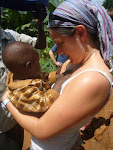Mmm, tea and avocado. deelish.
So, on Wednesday I went to Nakuru, visiting Kariandusi on the way. Getting the right matatu was easy enough, and I managed to get them to drop me off in the right place. There's a big sign saying Kariandusi Archaeological site so it's hard to miss. The curator there was a guy called Robinson. He'd only been there for a month, and found it necessary to give me his life story. Anyway, he had a guide take me around the site. It was quite interesting. Kariandusi is an Acheulian site, which basically means there's a lot of handaxes.

This is an obsidian handaxe. As if you couldn't read for yourself. They have a lot of them. They also have a lot of handaxes made out of trachyte.

This is the Upper Site. It's basically a lot of handaxes and choppers scattered on the area where they were dug up. Apparently in situ, although I doubt it.

This is some stratigraphy. It shows how the area has been covered in lake and erupted on and so forth.


This is a test pit, dug by John Gowlett, who is also the director of Kilombe where I'm digging briefly at the end of the month.


And thiiis iiis, the Lower Site. Much the same as the Upper site, but a bit lower down. It tells you all about it in the sign.
Enough pictures for now. It's a pain in the arse getting them positioned right and I'm leaving in 20 minutes. The area the site was in was also very pretty. Good for picnicking apparently. And there's a bit where you can see the stone tools still in section along the path.
There's also a diatomite mine in the area. You can see it from the Lower site, but for the photos you'll have to check out Jalbum when I put them up. You can see diatomite in the stratigraphy photo. It's the white stuff. Deposited by diatoms that lived when the lake was covering the site. Well, technically it is the diatoms that were in the lake. When they died they left this powdery, chalky residue which is now mined, for, umm, stuff. filtration is all I remember from the visit, but here Wikipedia helps me out: "Diatomaceous earth consists of fossilized remains of diatoms, a type of hard-shelled algae. It is used as a filtration aid, as a mild abrasive, as a mechanical insecticide, as an absorbentfor liquids, as cat litter, as an activator in blood clotting studies, and as a component of dynamite. As it is also heat-resistant, it can be used as a thermal insulator."
Lovely.
You can also see the old quarry where they used to mine the stuff. I have pictures of it, and of the tunnels they used. They look pretty cool.
Then I had a look around the old 'museum' which is just an explanation of what the rift valley is, how the area was formed, as well as some casts of early humans and descriptions of the tools and who used them and stuff like that. Brief but informative. They are currently in the process of making a new 'museum' which is more modern and will give more information as well as being more interactive. But I say "currently" and "in the process". This new museum started to be built and made about 2 years ago. Now the few displays and stands they had put there are looking tatty and tired already. But I think with a new curator in place it might start to get moving again. They all seem hopeful there anyway, and the director (of National Museums Kenya) visited a week before to see the site and what was going on with the new space. It's a nice area and has loads of potential, if they can just do something with it!
They also have a tool making area, which apparently Mwangi is in charge of (he's the guy from the archaeology dept in the museum who tried to explain to me and the Ugandan ladies how the accession system works in the stores, seemingly without really knowing what he was doing himself). It seems he's very big on the getting people to the archaeology side of things, and I think he'd be far more suited in a role where he gets to take people to sites and market them. Which he seems to do anyway. So he takes school groups to this site where they can look at all the stone tools, learn how to make them with obsidian from the neighbouring mountains (presumably where it would have come from in acheulean times) and then butcher a goat with them. I believe they also cook and eat it. Sounds like fun. Sounds like primtech!
So after having a good look around I went to have a chat with Robinson, which is probably to uninteresting to write here! :) There were a group of Canadian Archaeologists there when I arrived though (well according to Robinson they were Canadian Archaeologists) who it seems are touring Kenya in a big safari bus. Looks like fun.
Right, I'm heading off out to dinner, and I'll hopefully write the rest up later. Ciao!





No comments:
Post a Comment